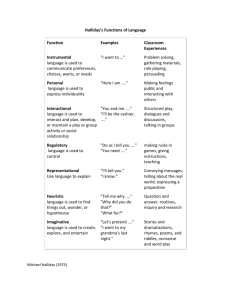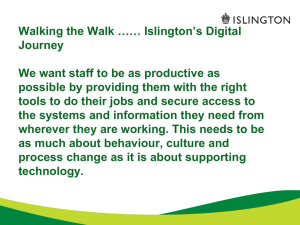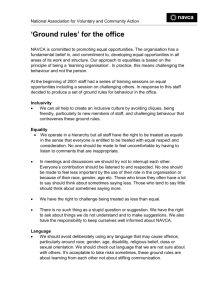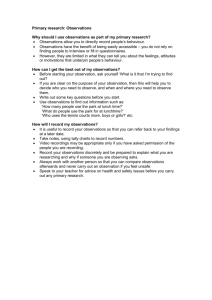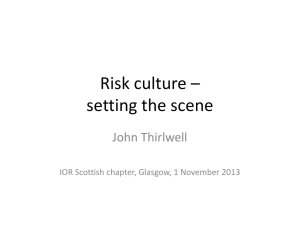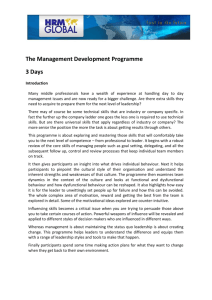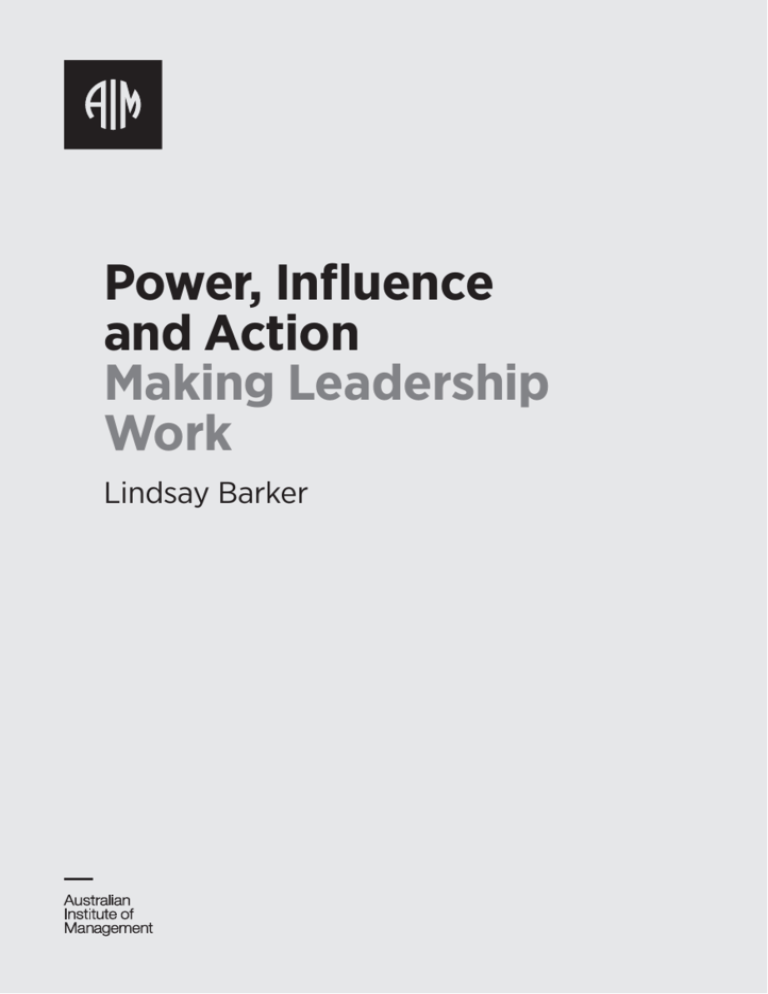
Power, Influence
and Action
Making Leadership
Work
Lindsay Barker
In Short
Leaders exist in organisations to make things happen that would not
happen in their absence. No mystery should be attached to leadership,
as it involves nothing more than the exercise of a power to influence
people towards the achievement of desirable outcomes.
Leadership requires the possession of a well-defined set of capabilities
and skills, none of which are limited to an elite few. Any person with the
desire to lead and a degree of commitment and purpose demanded by
the situation can acquire and exercise them
Principled purpose is the basis for the exercise of the power to
influence, which causes followers to make things happen. No checklist
or institutional manual can prescribe power to influence actions for all
situations. Instead leaders have the capability to exercise their power to
influence in many different forms depending on the characteristics of
the task in hand, the people involved and the environment or context
within which leadership is being exercised.
There is no single leadership style but a series of behavioural patterns,
which can be located along a power to influence spectrum between
the limits of coercion and engagement. Some situations may demand
coercion to demolish entrenched obstructions to achieving legitimate
purposes. Here application of pure persuasive influence power would
have little impact. At other points along the spectrum the use of coercive
power would kill creativity and engaged followership.
Each leadership situation requires insightful assessment and skilful
action selection. Not easy, but by no means beyond the capabilities of
many people now working and living in organisations.
Information Age Leaders
Business environments in Australia and throughout the world are
becoming increasingly more complex and uncertain. The stability
that enabled strong controlling leaders to rise and flourish through
the industrial age has gone, along with work that was understood by
both managers and workers (even if the desired outcomes were often
vigorously disputed).
Now that many of the industrial age jobs are no more, the work landscape
has vastly changed. Modern work is rapidly evolving and is often
knowledge based. It is emerging as a series of shifting patterns, and this
provides few opportunities for the development of a shared meaning of
work based on organisational identification and loyalty.
Yet, information age leaders are required to establish shared purpose
in this ever-changing, uncertain context, a task that by its very nature
cannot be discharged by any one particular way of leading. Instead,
leader behaviour is now required to be immensely variable and is shaped
by understanding:
• The people to be led.
• The task to be achieved.
• The context in which leadership is offered.
What is leadership?
Since ancient times leadership and its consequences have been a matter
of interest to individuals and societies. This interest has intensified as
societal structure has changed and become increasingly complex. Despite
this on going attention, however, little consensus has been achieved
regarding what leadership actually is. It has many meanings for many
people, and a multitude of definitions now exists regarding what it is
and should be. There is, however, an agreement that both leaders and
leadership are essential if organisations are to achieve their aims.
Extensive leadership studies throughout the last century focused
on trait and style. These approaches have had limited impact, except
perhaps to firmly establish that there is no one set of behaviours which
evoke leadership in all situations. The trait and style approaches equate
leadership with supervision in one form or another. They are, therefore,
difficult to apply in the modern context where organisations must be
viewed as complex adaptive organisations that exist and operate as
living systems in a rapidly changing and highly uncertain business
environment. Supervision is now a secondary consideration.
With such organisational and environmental complexity in mind, our
efforts to understand leadership must now move towards the concept of
strategic influence rather than remaining with structural determinants
and narrowly focused interpersonal relationships. The emphasis centres
on building networks of engaged followers who share the meaning of
the desired outcomes with the leader. The form of influence employed
(and how it is exercised) varies immensely. Its selection and application
constitutes the art of leadership.
Leadership: the power to influence
The discussion of leadership in this chapter is built upon the premise
that the essential nature of leadership is its power to influence the
behaviour of people towards achieving goals considered by the leader
to be important. This is consistent with the short insightful definition
offered by Rost who states that:
Leadership is an influence relationship among leaders and followers
who intend real changes that reflect their shared purposes.
The beauty of this definition is that it tells us that there is nothing
mysterious or unique about leadership and that it is a capability any
individual can acquire and exercise. Whether or not individuals seek
to acquire and exercise leadership capabilities will depend on a host
of social and physical factors. Hence leadership behaviour is readily
achievable by some whilst posing difficulties (even impossibilities) for
others.
Potential for leadership requires an individual to have some
understanding of the self, some communication skills, and a very large
measure of commitment and persistence. These capabilities will come
easily to some (through genetic predisposition and experience) and for
others will be harder to achieve.
It is not difficult to see why in the past, leadership was seen as the
preserve of ‘gifted’ people, who possessed personality traits that enabled
them to influence others towards the achievement of organisational or
societal goals. The key word here is influence. Whilst today’s concepts
of leadership are generally more egalitarian, there are few definitions
which do not include or infer a capacity to influence. Leadership then,
when broadly conceptualised, is the exercise of power.
Power
Power is part of the fabric of every social system. As with all other
external and internal environmental impacts, individuals and groups
who constitute the living system that is the organisation experience,
interpret and respond to power differently. It is yet another factor that
contributes to organisation complexity and is therefore difficult to define
and assess.
Pfeffer has this to say about the concept of power:
Most definitions of power include an element indicating that power is
the capability of one social actor to overcome resistance in achieving
a desired objective or result. For instance, Dahl (1957) defined power
as a relation between social actors in which one social actor, A, can get
another social actor, B, to do something that B would not otherwise
have done. Power becomes defined as force, and more specifically force
sufficient to change the probability of B’s behavior from what it would
have been in the absence of the application of the force.
Thus power may be conceptualised as a force, a force that is sufficient
to probably bring about behavioural change. Power, therefore, can give
rise to influence. The desired behaviour, action or outcome determines
which influence strategy is required for a particular situation. In turn,
the influence strategy defines the characteristics of the power needed to
influence.
Power to influence
Influence is the prime leadership tool for causing others to expend effort
directed towards achieving goals that the leader believes to be valuable.
The word influence has a wide range of meanings including the exercise
of power in its various forms. In relation to leadership, power to
influence covers a spectrum of behaviours. At one end of the spectrum is
the power to force actions from others through the exercise of position,
social status, or wealth (coercion). The opposite end is the power to
sway, to persuade, to cause individuals to become followers through
participation in the achievement of outcomes that have mutual meaning
(engagement).
Coercion as a source of power to influence is usually excluded from
leadership discussions because of the negative connotations associated
with the term. But as Gardner comments:
Elements of physical coercion are involved in some kinds of leadership;
and of course there is psychological coercion, however mild and subtle,
including peer pressure, in all social action. But in our culture, popular
understanding of the leadership process distinguishes it from coercion
– and places those forms involving the least coercion higher on the scale
of leadership.
Clearly there are times when leaders are confronted with bastions of
resistance, fiercely defended and placed across the path to organisational
purpose achievement. In such cases the exercise of power derived from
coercion is a legitimate leader behaviour choice.
It would be a rare leader, however, whose exercise of power could be
located at either extremity of the coercion-engagement spectrum. It
is true that history has seen no shortage of tyrannical leaders whose
cruel and despotic behaviour could be described as wholly coercive.
Their leadership tenure, however, was rarely long term. Other tyrants,
whose behaviour was situated further along the coercion-engagement
spectrum, retained their hold on a leadership position for much longer
periods. There are many examples of individuals whose vision and
solutions to the problems of their time were heavily weighted towards
coercive behaviour but attracted significant numbers of people who
chose to become followers. When the outcomes achieved fell short of
the benefits envisioned, followers sought to remove themselves from the
relationship (but often were unable to overcome the forces of coercion
exercised by the leader they installed). Leadership had been replaced by
dictatorship.
At the other end of the spectrum, leadership where power to influence
is derived solely from vision, inspiration and engagement is a rare
phenomenon. This is because of the intense effort required by the leader
to demonstrate extraordinary vision, highest levels of values adherence,
and exposure of self. Some examples are the great religious leaders who
lived their visions and articulated them with a compelling clarity and
persuasive intent that few can emulate.
So, no matter what the leadership situation might be, leaders exercise
power to influence followers so that they align their behaviour and
create and direct their collective efforts towards attaining desired
goals. Influence, however, is a dynamic event - whilst leaders influence
followers, followers also influence leaders. Such reciprocity gives rise to
reciprocal influences based on shared understanding between leaders
and followers on desirable future outcomes. It is only then that high
levels of organisational performance become possible.
The elements of successful leadership
Rosabeth Moss Kanter considers leadership to be one of the most
enduring, universal human responsibilities. She points out the many
similarities in the practice of leadership across historical eras and
civilisations and the wide range of disparate figures, including Jesus
Christ and Attila the Hun, whose leadership behaviours have been
extensively analysed and copied. She comments:
Thus, in many important ways, leaders of the future will need the traits
and capabilities of leaders throughout history: an eye for change and a
steadying hand to provide both vision and reassurance that change can
be mastered, a voice that articulates the will of the group and shapes it to
constructive ends, and an ability to inspire by force of personality while
making others feel empowered to increase and use their own abilities.
Conceptualising leadership as power to influence is nothing new.
In various forms and words it has been a pervasive influence in the
leadership literature since early times. Now in these times of change
and complexity it is necessary for leaders to become professional
practitioners with a highly developed skills base. They must also have
an understanding of what is required of them for successful leadership
and how they can build their capabilities to meet such requirements.
Three basic requirements to be met by anyone offering leadership are:
• A capacity for looking into the self in order to identify patterns of
values and beliefs. This self-knowledge is the basis for deciding
when and how to exercise power to influence and thereby to exert
leadership.
• Knowing where to locate leader coercion–engagement behaviour
along the power-influence spectrum in the light of the prevailing
context (that is, knowing which type of leadership is required by the
situation).
• A capability to create the influence necessary to achieve the desired
outcomes (hence making leadership happen).
This framework is by no means limited to leadership (indeed, it is
nothing more than a version of the standard learning/thinking cycle
with its ‘Assess + Plan + Implement + Review’ steps). Each element will
now be discussed in some more detail and its place in the theory and
practice of leadership established.
Self-knowledge and values
Much of the voluminous leadership literature refers to the search
for workable recipes or cause-effect check lists, whose mechanical
implementation will make leadership happen. But no one can make
leadership happen. It is an intense personal phenomenon arising from
within an individual’s mind and which we all can develop.
More recently, the search for understanding of leadership has centred
around the impacts of personal values, the self, and the societal context
in which leadership is offered. This includes investigation of the concepts
of values and the self, as well as areas such as cognition, emotion and
genetic predisposition. While expressed in many ways, the sum of this
research recognises that:
• Values are the foundations of leadership behaviour.
• Self-understanding and mastery are the mechanisms of leadership
behaviour.
• An ability to articulate and project the vision embedded in an
individual’s values is an essential pathway to the minds of those who
may be followers.
A Segal and Horne comment:
The pursuit of self-knowledge is the work of a developed personality and
a characteristic of an enlightened leader. Self-understanding is the most
secure bed-rock on which to shape one’s life. Nothing is more important
in conditions of turbulence and change than a secure sense of self. Selfunderstanding also provides a basis for understanding others—it is
difficult to be conscious of another’s need, motivation, and processes
without first having awareness of one’s own.
Leadership involves a wide range of behaviours, but there is always one
constant which is the establishment of trust, even when behaviour is
weighted towards the coercion end of the power-to-influence spectrum.
To establish trust leaders must actively demonstrate possession of a value
set which includes integrity, openness, honesty, respect and fairness.
Which type of leadership is required?
There is nothing superhuman or mysterious about leadership. It is
a capability that any individual can acquire and exercise. That does
not mean, however, that everyone will wish to grasp the opportunity.
Managing the unmanageable, as Flood and others have stated, is not a
task that all are prepared to accept.
The carrot and stick form of power-influence is an alluring and seemingly
easy path to follow. Thus the behaviour of many organisational leaders
is still located too near the coercion end of the coercion-engagement
spectrum for them to achieve high levels of organisational performance
in the modern complex societal environment. On the other hand, as
stated earlier, engagement alone will not guarantee performance.
The power-to-influence continuum describes how a leader uses a
coercion-persuasion mix to influence others towards achieving desired
outcomes.
The two limits of the continuum are coercion-based leadership (that is
command and control behaviour) and subordinate-centred leadership
(that is persuasion and engagement behaviour).
When a leader is faced with a given situation, selection of an appropriate
point on the power-to-influence continuum is an essential initial
step. The behaviour point selected and the actions stemming from
it determines whether or not there will be effective leadership in that
particular people/task context.
Organisation’s external environment
Organisation’s internal environment
Coercion
Engagement
Leader’s power-to-influence behaviour
Coercion
Engagement
Tell
them
Sell
them
Check with
them
Include
them
Involve
them
Figure 4.1: Leadership Behaviour Continuum
Schein states that one of the most consistent findings by historians,
sociologists and empirically social psychologists is that leadership
should depend on the attributes of the leader, the employees and the
situation.
In practice, application of the power to influence approach revolves
around an accurate assessment of the coercion-engagement mix. This
is manifested by the degree of direction and interactive employee
involvement that is best applied to a given situation.
Goleman provides a useful analogy to illustrate the range of behaviours
required of leaders. He suggests they are:
“… As the array of clubs in a golf pros bag. Over the course of a game, the
pro picks and chooses clubs based on demands of the shot”.
…Sometimes he has to ponder his selection, but usually it is automatic.
The pro senses the challenge ahead, swiftly pulls out the right tool, and
elegantly puts it to work”.
Table 4.1 provides a summary of the attributes of the three forces (leader,
employees and situation) that a leader must consider when deciding the
coercion-engagement mix to be exercised and the corresponding level of
employee involvement.
Attributes of
the leader
Attributes of
the employees
Attributes of
the situation
• Leader value system
• Need for
independence
• Type of organisation
• Leadership
inclinations
• Readiness to assume
responsibility for
decision making
• Feelings of security in
an uncertain situation
• Tolerance for
ambiguity
• The problem
itself—information
throughout the
organisation
• Need for control and
certainty
• Interest in the
problem
• Confidence and trust
of subordinates
• Group effectiveness
• The pressure of time
• Understanding of, and
identification with, the
organisation’s goals
• Necessary knowledge
and expertise to deal
with the problem
• Expectations of
sharing in decision
making processes
Table 4.1: Choosing Leadership Behaviour
Attributes of the leader
It is the leader’s values that allow him/her to operate in a unique way,
incorporating background, knowledge and experience. The leader’s
beliefs and personality will determine if he/she favours more or less
employee involvement is necessary to achieve desirable outcomes.
The leader’s value system influences propensity to allocate power. Some
leaders strongly believe employees should participate in decisions
affecting them. Others feel involving workers in management work
is passing the buck. Such views obviously influence their approach to
decision making. Another key value question is the relative importance
the leader attaches to short-term organisational efficiency and longterm employee development.
Need for control and certainty may cause one leader to be more directive
than another leader who feels comfortable allocating responsibility.
When a leader releases some control over decision making, there is
a reduction in the predictability of its outcome. Leaders with more
tolerance for ambiguity and surprise are more comfortable delegating
than their risk-averse counterparts.
Some leaders seem to function more naturally as highly directive
leaders. Resolving problems and issuing orders comes easily to them.
Others are more comfortable and experienced in sharing their work with
subordinates.
The leader’s confidence in the abilities of employees is also important.
Leaders who have more trust in other people generally, and in their
employees specifically, are better able to solicit and effectively utilise
employee participation in decision making.
Leaders develop a pattern of habits that contribute to their leadership.
These habits can be hard to break, but with commitment, they can be
changed.
Attributes of the employees
A leader’s confidence in employees will depend on the factors previously
discussed, but will also be influenced by employee ability and interest.
Leaders must assess the extent to which employees will accept
responsibility if they are given the training, materials, time, and freedom
to act. Some employees tend to be negative and blame everyone but
themselves when things go wrong. Others may only pretend to follow
instructions.
Effective interpersonal skills are critical when dealing with employees.
There is a general consensus that involving employees is usually more
productive if they demonstrate that they:
• Have the knowledge and experience relevant to the issue at hand.
• Have an interest in the issue and appreciation of its importance.
• Have an understanding of, and agree with, the goals of the
organisation.
• Desire autonomy, responsibility and growth.
• Are able to tolerate uncertainty and ambiguity, as opposed to need
for structure.
• Have had previous involvement in decision making.
Attributes of the situation
Some of the more important situational forces leaders must consider
arise from the type of organisation, its culture and established decision
making practices. Organisations tend to select, promote, and retain
people who fit in with their prevailing management philosophy. ‘The
way we’ve always done it here’ has a profound impact on how it will be
done in the future.
Leaders must consider how effectively their employees will work
together as a unit before handing over decision making responsibilities.
When teams work successfully together there is an efficient use of time
and energy which produces a focused synergy. Trust exists between
members and there is a belief that all team members will perform in
ways that will contribute to the intelligence and dynamics of the team.
High-performing work teams are able to effectively dialogue with one
another.
Greater employee involvement is called for when information relevant to
the problem is widely dispersed in the organisation, and when employee
acceptance is critical to the implementation of whatever decision is
made.
In the short run, shared decision making generally takes longer
than unilateral action. It is not surprising to find that crisis-ridden
organisations often operate with a highly authoritarian management
style. The pattern perpetuates itself since manager-centred responses to
crises do little to develop employee engagement.
Regardless of the approach, leaders when exercising their power to
influence need to carefully communicate with employees about their role
in the decision process. For example, a leader may only want employees
to provide ideas about developing options for resolving a problem. The
leader may then make the final decision themselves. If employees get
the idea the leader is delegating the responsibility to them, confusion
and resentment are likely to follow.
Employee participation
A successful leader is one who is aware of the forces which are most
relevant to their behaviour at a given time and is able to make an
appropriate behaviour choice along the power-influence spectrum.
Leaders must understand themselves, the group they are dealing with,
and the operating environment if they are to be successful.
Having considered the attributes of the leader, the employees and the
situation, a leader must then select the appropriate level of employee
participation that will make things happen through the chosen powerinfluence behaviour. These levels are described below.
It should be noted that repeated use of one level of employee involvement
is incompatible with the power-influence approach. The appropriate level
must be determined and communicated clearly to the people involved.
Tell them
The leader makes the decision and announces it. The leader identifies a
problem, considers alternative solutions, chooses one, and then reports
it to employees as an order for implementation. The leader may or may
not consider what employees will think about the decision. In any case,
the leader provides no opportunity for employees to participate in the
decision-making process:
Please start making the door mouldings now.
Sell them
The leader makes the decision and explains the reasoning to employees
in an effort to gain their acceptance. The leader takes responsibility for
identifying the problem and generating the solution, but recognises the
possibility of some resistance among those who will have to execute it.
The leader may indicate to employees what they have to gain from the
decision:
Start making the door mouldings now. We are required to have 400 doors
fully assembled by tomorrow, and we will hold up the final assembly
stage if we have insufficient mouldings available.
Check with them
The leader presents the decision as an idea and invites questions and
comments. Here the leader has arrived at a tentative decision but provides
an explanation of their thinking and gives employees an opportunity to
influence it. The leader retains the initiative for diagnosing the problem
and the final decision but solicits reactions from affected employees:
I’m thinking of purchasing an additional door moulding unit. It will
increase our capacity to produce door mouldings at short notice and
should increase productivity by 30%. What do you think?
Include them
The leader presents a problem, asks employees for ideas and suggestions,
and then makes a final decision. Again, the leader ultimately decides,
but the employees provide and analyse much of the information on
which the decision is based. The leader benefits from their knowledge
and experience:
Our records show that we are falling behind in our production of door
mouldings. Why do you think it happened, and what can we do about it?
Involve them
The manager passes the decision-making responsibility to employees.
The leader points to the existence of a problem, outlines constraints on
solutions, and essentially makes a commitment to accepting whatever
the employees decide within prescribed boundaries. The employees
diagnose the problem and consider alternative ways of handling it. If
the leader participates in the decision-making process, they does so as
an equal member of the group involved:
We’ve got to boost our production of door mouldings. Let me know if you
can possibly increase levels, how you’ll do it, and what extra expenses
we’ll have to incur.
Making leadership happen
Leadership as conceptualised here depends on accurate behaviour
selection along the power to influence spectrum. This gives rise to
a coercion-persuasion mix that will make the things happen that the
leader wants to have happen.
As mentioned earlier, however, choosing the right leadership for the
situation is only part of the process. To maximise achievement it is
also necessary for the leader to employ high level communication and
motivation skills to:
• Assist followers to understand the organisation vision by creating a
shared meaning of its value and importance.
• Assist followers to realise their potential.
This is what high-level performance is all about — people working
together towards shared goals which have meaning for them and will
allow them to contribute at their full potential. It is the Holy Grail of
leadership.
Reiley stated that:
Leadership is not about telling people what to do. It is not saying this
is the appropriate direction for us to follow. It is not about command
and control. Leadership is about helping others develop their own
understanding of what is important in helping an organisation move
towards its vision. Leadership is all about helping others realise their
potential.
Sharing the meaning
In order to achieve maximum results, leaders need to firstly help
employees to develop their own understanding of what is important for
the organisation. Only in this way is it possible to mobilise followers
throughout the organisation to move along together towards the
achievement of stated purposes. People will not willingly exercise their
capabilities to the limit of their potential if they are required to achieve
unknown goals (or possibly unacceptable goals that are known only to a
few). Establishing a shared understanding of purpose which penetrates
deeply into the ranks is one of the great leadership arts. How is it done?
By selecting the leader behaviour most likely to succeed and supporting
it with talk and presence. Communicating vision and purpose is a prime
task for all leaders from the CEO to the shop floor.
Realising follower potential
Leaders must always remember that organisations are people and
nothing else. They are very much alive and no matter what structures
and processes that may be devised and managed, people cannot be
forced to produce or perform.
People produce and organisations are enabling arrangements for them
to facilitate their productive work. People must be led, not directed,
towards goals they understand. Only then is there any likelihood of them
working to their potential. This is what high performance organisations
do and this is how they flourish in the modern complex, uncertain
environment while others die.
Assisting followers to reach their potential is a major leadership task
demanding the capability to persuade and engage.
Australian Leadership in action
The art of being a successful leader clearly requires high-level people
skills and the capability to consider a range of variables before choosing
appropriate leadership behaviour for each situation.
Four case studies have been selected to demonstrate how some
contemporary Australian managers, working in very different situations,
go about selecting their behaviour locations on the power-influence
spectrum. They all understand that they will behave differently according
to:
• The task.
• Employee attributes.
• The situation.
Leader profile: Tim O’Loughlin
At the time of writing, Tim O’Loughlin was the CEO for the Department
of Transport, Urban Planning and the Arts in South Australia.
O’Loughlin stepped into his role in September 2000, and did not see the
need to make his stamp immediately. He wishes to build on the already
productive culture that he was presented with. ‘Culture emerges as a
rational response to the environment’ states O’Loughlin. ‘Performing
as a leader and manager is not a mutually exclusive act. Both are a
balancing act.’
O’Loughlin perceives his leadership style as being middle of the road
on the power-influence continuum, leaning slightly towards the
authoritarian end. His leadership behaviour sits him between check
with them and include them most of the time.
When an issue has been debated for a considerable time and does not
appear to be drawing to a solution, O’Loughlin steps in to make the final
decision. He tells them what the final decision is.
O’Loughlin allocates decision-making powers to employees when he
trusts that they will make decisions similar to the way he would if he was
involved. ‘This usually occurs when they are high quality thinkers and/
or they have worked with me for a considerable time.’ O’Loughlin hands
over responsibility to staff that demonstrate a clear understanding and
application of risk management. ‘I can’t give responsibility to staff that
will always take the low risk option just to save their own necks.’
O’Loughlin has little time for teams, as he believes that individuals must
own responsibility and ultimate accountability for their decisions. His
experience tells him that teams, in the public service particularly, limit
the ownership of responsibility in individuals. He is more likely to hand
over greater decision making powers to employees who are willing to
challenge his point of view, and challenge the status quo.
‘Ninety-eight percent of people want to do a good job. It is the role of
leaders to help them reach their potential by trusting their judgement
so they believe in their ability to do the job. I am an outcome-orientated
leader with limited appreciation for process. I can’t stand it when huge
amounts of time are spent pondering process and procedures.’
O’Loughlin’s ideal leadership characteristics are:
• Strategic thinking.
• Flexibility and adaptability to change.
• Problem solving.
• Decision making.
• Independent thinking skills.
Leader profile: Bronwyn Halliday
At the time of writing, Bronwyn Halliday was the Director of the State
Library of South Australia. She is head of a $40 million redevelopment
of the library into a leading edge reference centre within the knowledge
economy, and a training and facilitating agent for new technologies for
accessing information. The redevelopment began in November 2000
and is expected to be completed in 2003. It represents one of South
Australia’s most high-risk and major public redevelopments.
Halliday admits that she had little technical knowledge about running
a library when she took on the role of director – her strengths are in
management and strategy. Halliday regards her leadership role as
being a facilitator, manager, persuader, consultant and servant to her
stakeholders. ‘Participative leadership is crucial when the technical
knowledge is distributed throughout the organisation’ states Halliday.
Halliday starts with the premise that a leader must trust all of his or
her employees. ‘When you better understand their strengths and
weaknesses, the areas of trust can be allocated with greater precision. If
you want your staff to trust you and the decisions you make, you must
also be trusting of your staff. To gain trust a leader must demonstrate
the values that they expect, like openness, honesty and sincerity.’
Halliday believes that she allocates power depending on her needs, the
requirements of her employees, and the activity at hand. Halliday’s
comfort zone does not require high levels of control and certainty. To
be autocratic would be foreign to her normal leadership style. She is
able to deal with unpredictability within the organisation and external
environments. Living with ambiguity becomes the norm.
When Halliday commenced her position at the State Library there was
an established culture where employees owned much of the power in
making the operational, and some of the strategic, decisions. ‘I had to fit
in with the way they did things. Fortunately, my leadership style fitted
the culture.’
Halliday’s position on the power-influence continuum is dominated by
include them leader behaviour. When Halliday was faced with how the
library should operate during the redevelopment she asked her staff
what should be considered and what strategies should be employed.
One dilemma the library was faced with involved having large numbers
of the public and staff on site during the upgrading of buildings. Their
inputs were considered and Halliday made the final decision. ‘Ultimately
I’m the one to take the can so I should be able to make the final decision.
If the wrong decision is made, I’m the one the Minister and the Board
will hold accountable.’
When Halliday has little subject knowledge of an operation she adopts
an involve them position on the power-influence continuum. Employees
make the decision within the allocated resources provided. When
strategy is involved, however, Halliday shifts towards the authoritarian
end of the continuum. ‘As a leader you are required to have a big picture
view of the organisation and the environment in which it operates.
Strategy must consider the ramifications within the complex array of
interrelationships within the organisation and its environment where
the role of the leader must excel.’
When a decision ultimately made by Halliday has an impact on all staff,
she sells them the decision at staff meetings and internal communications.
When a decision involves an individual or a small group, she will include
them. ‘It is not possible to consult all staff on every decision. There is
simply not the time available.’
In general, Halliday chooses to avoid telling her staff of a decision
without their input first. However, ‘There are times when allocating
time to developing consensus is impractical.’ For example, when a staff
member approached Halliday to include the latest released books in a
non-secured area, Halliday responded with ‘No - the risk of these books
being stolen was high. End of story.’
Halliday believes that the ideal characteristics of a leader are:
• People skills.
• Ability to think strategically with a vision.
• Flexibility and adaptability.
• Honesty.
While it is an asset that the leader is able to solve complex problems,
capable employees are able to take on much of this role. Staff can also
take on the technical, innovative and inventive roles.
Leadership profile: Daryl Jacobs
At the time of writing, Daryl Jacobs was the Marketing Manager of
Wendy’s (well known for their ice creams). He regards his leadership
style as generally being laissez faire. Most of Jacobs’s decisions are made
in consultation with staff. Organisational functions where Jacobs has the
technical knowledge usually involve Jacobs presenting the problem to
his Marketing Department staff for discussion. Jacobs may present his
proposed method for dealing with the situation for their comment. The
final decision may be adopted after staff input, at Jacobs’s discretion.
Jacobs’s leadership style becomes more directive when:
• The decision requires considerable allocation of resources, is within
his area of expertise or when there are no available staff with the
necessary expertise.
• There is a short timeframe.
• The executive regard the decision as being in a priority performance
area.
When Jacobs makes a decision without staff input (for example, when
the Executive has mandated the launch a new product) he usually sells
them the decision.
Jacobs’ predecessor had a more autocratic leadership style and staff were
used to being told what they needed to do. They had little participative
involvement in decision making processes.
When Jacobs stepped into his role of Marketing Manager two years ago
at Wendy’s, employees were used to passing all of their decisions through
the boss. Jacobs endeavoured to develop a marketing department where
the decisions were made by the team, rather than relying on Jacobs for
his input. He also sought to delegate decision making, where possible,
to his staff to create ownership. This occurred to some extent, but he
discovered that some staff did not want the responsibility. ‘We ran Myers
Briggs personality tests on all of our staff last year. I now know which
staff seek the most independence, and those that prefer a more directive
style of leadership.’
When choosing whether to hand over his decision making powers
for a given project, he considers the individual employees need for
independence. For example, when Jacobs was approached by an
employee to increase her responsibilities he provided her with the
decision making powers that he would have normally kept to himself.
Jacobs made sure that the employee had the necessary understanding
of the processes involved in the new areas of responsibility through
mentoring. The employee felt empowered and found her new role much
more rewarding.
Jacobs happily hands over decision making power to his subordinates
when he lacks the technical knowledge to make an informed decision.
When Executive recently requested the introduction of new flavours
in the Wendy’s ice cream range, Jacobs handed over the full decision
making powers to the Product Manager and marketing team. ‘I present
their new flavours to management and back their decisions to the hilt,’
said Jacobs. ‘It is one thing to state that your staff have the final say, but
another to fully support their decisions with management. I let my staff
know that I totally supported their decision, as if I had made it myself.’
Jacobs does not perceive himself as a risk taker, preferring to normally
take the middle ground. He does not normally feel comfortable with
unpredictable outcomes. So when risk is involved in a project at Wendy’s,
he takes an active decision making role.
Jacobs rated the most important characteristics of a leader as:
• People skills.
• Team playing.
• Sincerity and genuineness.
• Ethics/personal standards.
• Openness.
• Directness.
Leadership profile: Steven Marshall
Steven Marshall is a joint Managing Director of Marshall Furniture, one
of Australia’s largest furniture manufacturers. Marshall perceives his
leadership style as autocratic and highly directive.
Marshall is a self-confessed dictator, who believes there is no time to
include participation from employees in decision making. His style is
very much tell them, and he does not feel comfortable adopting the more
democratic styles of some of his colleagues. Marshall states that many
of the decisions made by management on a daily basis could not include
staff in the process because there is simply not enough time available.
Marshall’s personal needs push him to the authoritarian end of the
power-influence continuum. In areas where he lacks technical expertise,
however, staff have the full responsibility for making the decisions with
little or no involvement from management.
When Marshall experiences large amounts of stress in his work he
admits to behaving reactively. ‘I am less likely to include staff in decision
making when I have much to achieve in a short time. I tend to consult
with staff when I have time to do so,’ states Marshall.
He perceives the furniture manufacturing industry as being made up
of mostly directive leaders that lack the modern democratic, leadership
style that many leaders of today aspire to.
He does not feel comfortable with his staff making the most important
decisions in his organisations. ‘They lack the understanding of the
industry and broader environments to be able to think strategically. Its
part of the industry culture.’
Marshall rates employee trust of management as being low in his
organisation, but felt that this had little impact on organisational
performance. He sees value in empowering staff on an operational
level, but unless they understand the multitude of environmental and
organisational drivers, they cannot begin to contribute to developing
strategy.
Marshall rates the most important characteristics of a leader as being:
• Strategic thinking.
• Flexible and adaptable to change.
• People skills.
• Independent thinkers.
• Being a visionary.
Conclusion
Leaders exist in organisations to make things happen that would not
happen in their absence. No mystery should be attached to leadership as
it involves nothing more than the exercise of a power to influence people
towards the achievement of desirable outcomes.
It was the aim of this chapter to emphasise the need for leaders to examine
and skillfully choose from their leadership skills and understandings in
selecting particular leadership behaviour when faced with an array of
situations and groups of people. No one set of leadership behaviours
can always ideally suit to the complex array of situations faced by any
leader of a modern complex adaptive organisation. To lead effectively,
to influence followers to achieve the goals of an organisation, a leader
must demonstrate flexibility in adapting his/her dominant or preferred
behaviour to the situation and the people who must be fully engaged in
the activity at hand.
There is no single leadership style but a series of behavioural patterns
which can be located along a power to influence spectrum. Some
situations may demand coercion to demolish entrenched obstructions
to achieving legitimate purposes. Here application of pure persuasive
influence power would have little impact. At other points along the
spectrum the use of coercive power would kill creativity and engaged
followship.
Each leadership situation requires insightful assessment and skilful
action determination. Not easy, but by no means beyond the capabilities
of many people working and living in organisations.
Leadership requires the possession of a well defined set of capabilities
and skills, none of which are limited to an elite few. Any person with the
desire to lead, with a degree of commitment and purpose demanded by
the situation, can acquire and exercise successful leadership behaviour.
No check list or institutional manuals can make a person a leader,
leadership is not an end in itself.
The one constant spanning all leadership behaviour is integrity. Without
demonstrable integrity there can be no trust, and leadership, no matter
how offered, will not be accepted. Followers will only align themselves
with leaders whom they assess as being honest, ethical and who are seen
to value their integrity above all else.
Successful leaders will never compromise their integrity no matter where
their assessment of people, task and context leads them to position their
behaviour along the power to influence spectrum.
For further exploration
Harvard Business Review on Leadership (1998) Collection of articles by
Mintzberger, Kotter, Zaleznik, Badaracco, Farkas and Wetlaufer, Teal,
Heifetz and Laurie, Nohria and Berkley, Harvard Business School Press,
Boston
A comprehensive leadership literature review. Explores the development
of leadership thought and is very good background reading.
Hesselbein, F., Goldsmith, M., Beckhard, R., editors (1996),The Leader
of the Future, Drucker Foundation Future Series, Josey-Bass Publisher,
San Fransisco
Has a wide range of articles by recognised leadership authors. Very U.S.
orientated but explores many leadership concepts and situations which
have universal application.
Kouzes, James M. and Posner, Barry, Z., (1997) The Leadership Challenge:
How to Keep Getting Extraordinary Things Done in Organizations,
Jossey-Bass Publisher, San Francesco
Strongly orientated to values based leadership. Establishes the case for
integrity as the essential leadership characteristic.
Roland L. Daft (1999), Leadership: Theory and Practice, Fort Worth FL.
The Dryden Press, Harcourt Brace.
A modern leadership text book suitable for college and university
leadership courses.
References
Rost J.C. (1993) Leadership for the twenty-first century, Westport, CT: Praeger
Rost J.C. (1993) op cit.
Pfeffer J. (1981) Power in Organizations, Marshfield MA: Pitman Publishing Inc. p.2
Gardner J. (1990) John Gardner on Leadership, The Free Press: New York, p.2.
Moss-Kanter R. (1996) World Class Leaders; The Power of Partnering, in F. Hesselbein, M. Goldsmith,
R. Beckhard, (eds.), The Leaders of the Future: New Visions, Strategies, and Practices For The Next Era,
San Francisco: Jossey Bass, p.90
Segal S., Horne D. (1997) Human Dynamics, Cambridge MA: Pegasus, p. 56
Flood R.L. (1999) Rethinking the Fifth Discipline: Learning Within the Unknowable, Routledge, New York
and London.
Schein E. (1997) Organisation Culture and Leadership, Jossey-Bass Business Management Services
Goleman D. (2000) ‘Leadership That Gets Results’ Harvard Business Review Vol. 78, Issue 2, PP.78 90
Adapted from Tannenbaum and Schmidt, ‘How to choose a Leadership Pattern,’ Harvard Business
Review, May-June 1973.
Reiley J (1999) ‘Exponential Organisational Growth: Learning to Survive Success’, National Productivity
Review, Vol. 18, No 4, p.55-58
Report of the Industry Task Force on Leadership and Management Skills (April 1995) Enterprising Nation:
Renewing Australia’s Managers to Meet the Challenges of the Asia-Pacific Century, Commonwealth of
Australia
About the Author
Lindsay Barker, AM, BSc(Hons), MSc, BEd(Melb), PhD(NEB), FACE,
FAIM
After working extensively and teaching in the field of engineering,
Lindsay Barker was appointed the Founding Director of the Darling
Downs Institute of Advanced Education, which in 1990 became the
University College of South Queensland (USQ). Dr Barker was appointed
the first Vice Chancellor of the new University, and was instrumental in
developing the USQ distance education program, the precursor to their
world class e-learning initiative.
After leaving USQ, Dr Barker spent many years in the United States
pioneering distributed education methodologies and consulting to
global companies across all industry sectors.
Dr Barker returned to Australia to work for the University of South
Australia. He was later appointed Emeritus Professor and Head of the
School of Marketing, the position he held at the time of writing.
A Fellow of the Australian Institute of Management, Dr Barker’s major
interests were in leadership, strategy, planning and organisation
dynamics. He taught within this subject range throughout the world.
Lindsay Barker’s aim was to make a major contribution in the emerging
networked world, and he is remembered for his passion and dedication
to making quality education available on a global scale.
© Management Press 2009
www.aim.com.au
Published by Management Press
Australian Institute of Management (Group) Limited
369 Boundary Street, Spring Hill Queensland Australia 4000
First published 2001 by McGraw-Hill Australia Pty Ltd
The moral rights of the author have been asserted.
All rights reserved. Except as permitted under the Australian Copyright Act
1968 (for example, a fair dealing for the purposes of study, research, criticism
or review), no part of this book may be reproduced, stored in a retrieval
system, communicated or transmitted in any form or by any means without
prior written permission. All enquiries should be made to the publisher at the
above address.
Disclaimer
The material in this publication is of the nature of general comment only. And
neither purports nor intends to be advice. Readers should not act on the basis of
any matter in this publication without considering (and if appropriate, taking)
professional advice with due regard to their own particular circumstances. The
author and publisher expressly disclaim any liability to any person, whether
a purchaser of this publication or not, in respect of anything and of the
consequences of anything done or omitted to be done by any such person in
reliance, whether whole or partial upon the whole or any part of the contents
of this publication.

